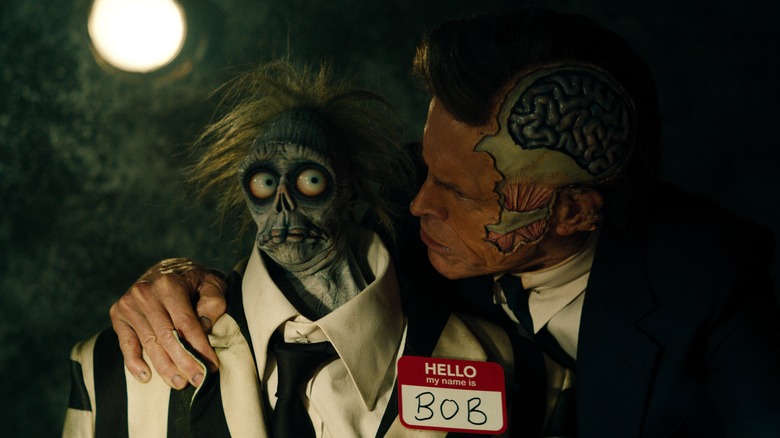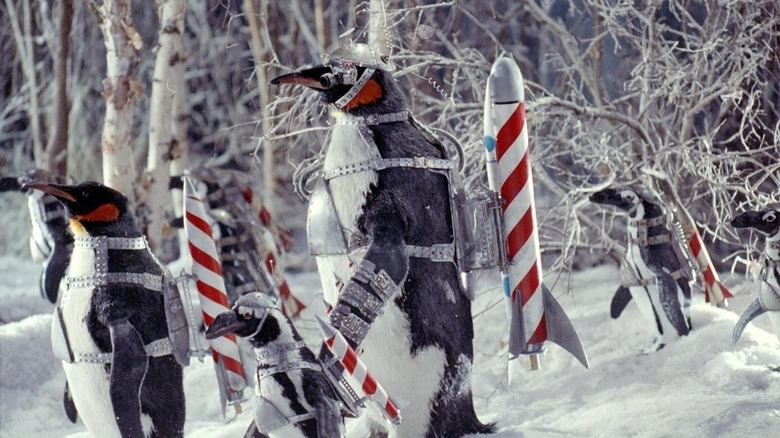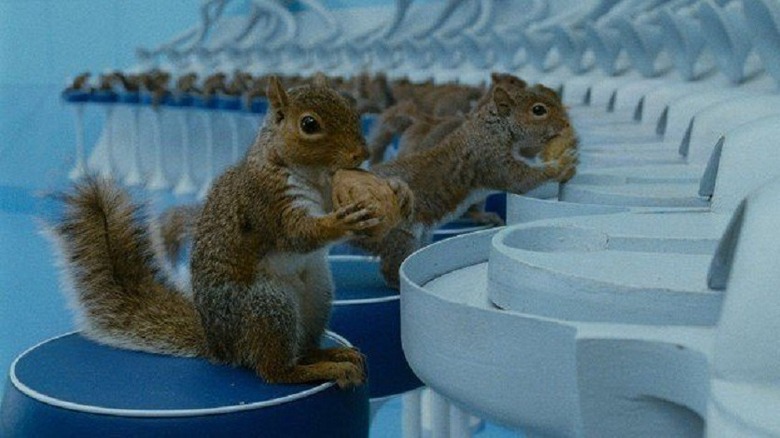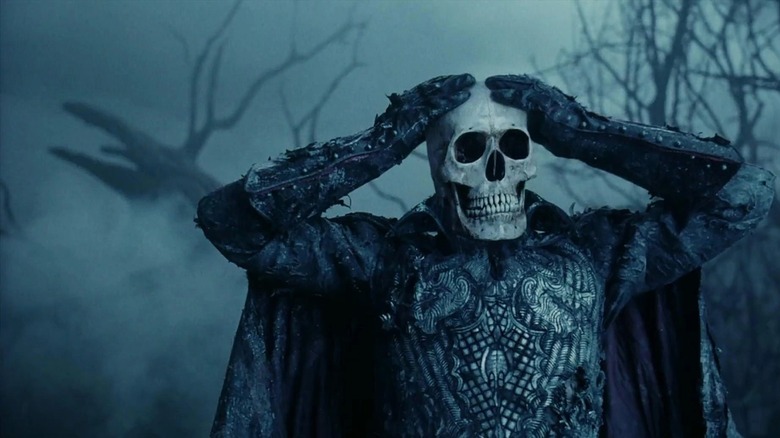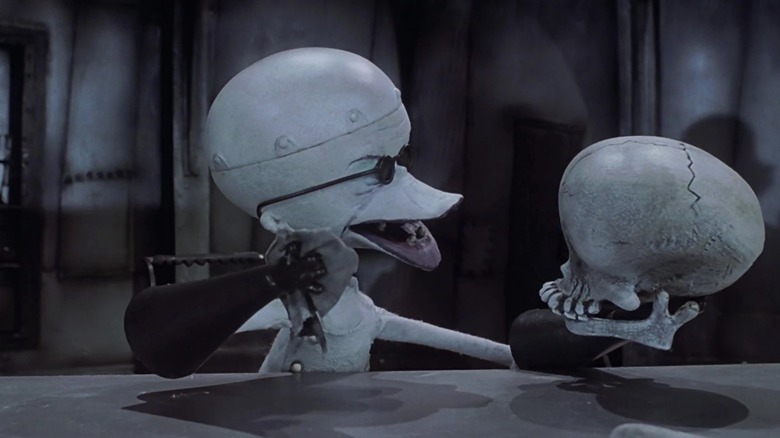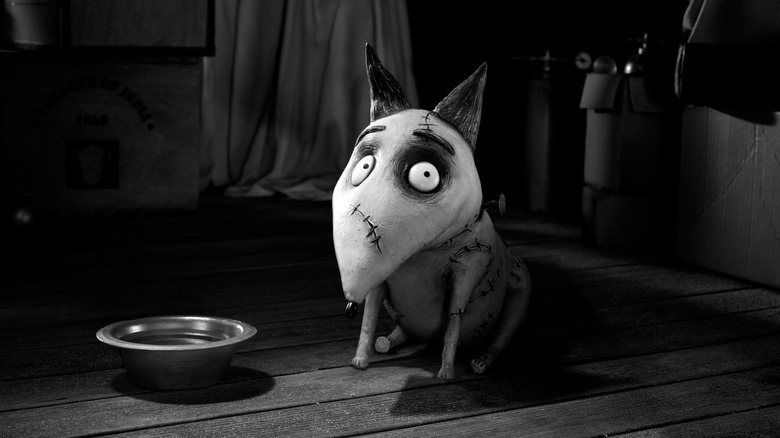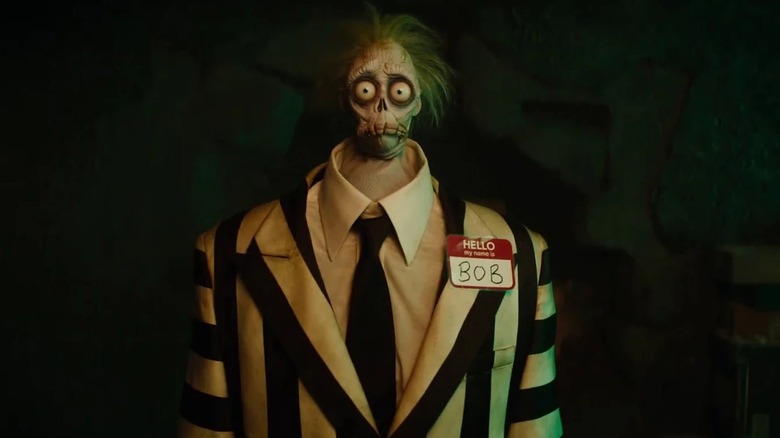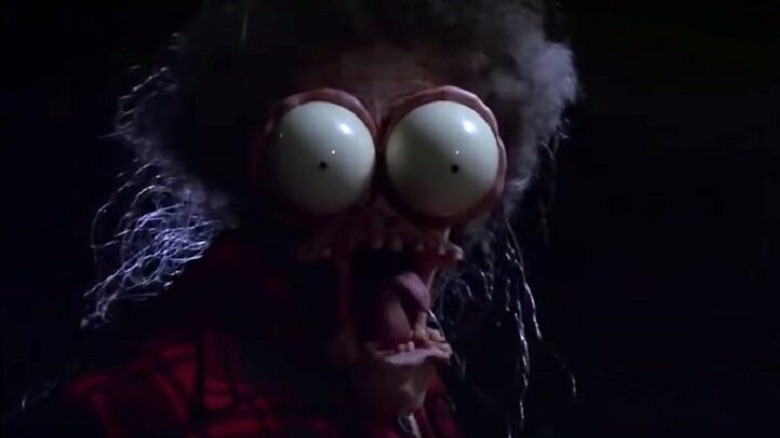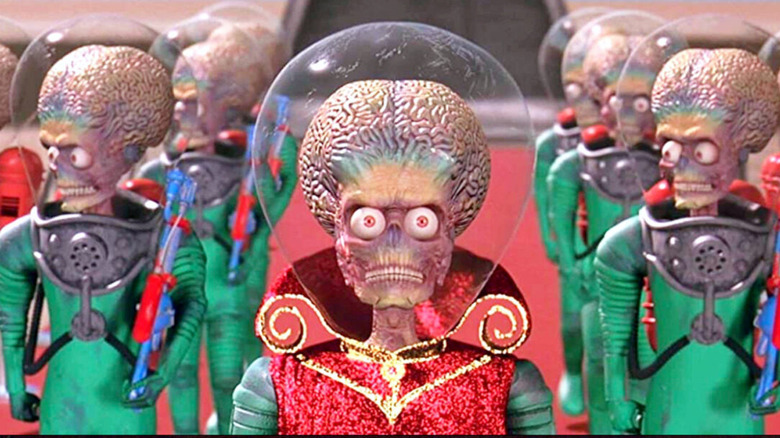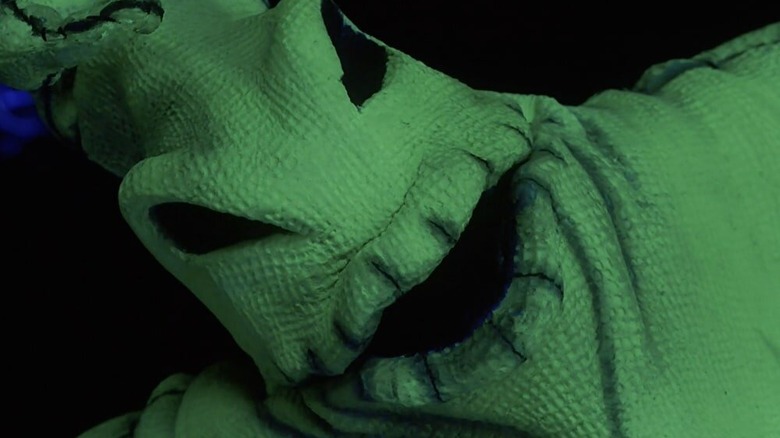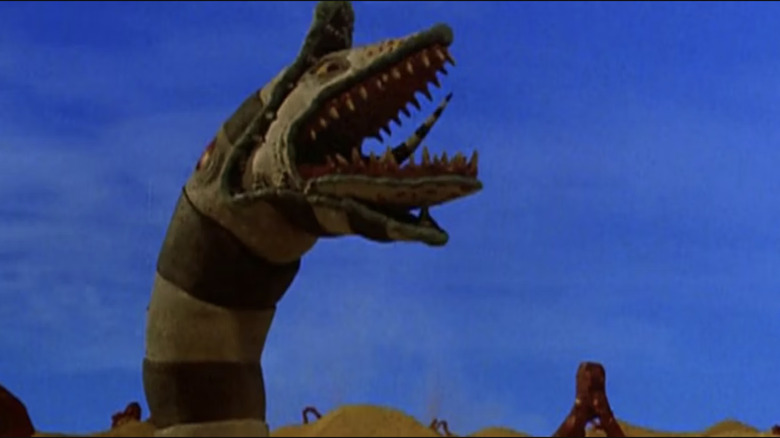The 10 Best Creatures In Tim Burton Movies, Ranked
The films of Tim Burton are known for their baffling, unique, and unforgettable creations. These films are as focused on a visual aesthetic and the designs within that aesthetic as they are on the people and stories. Though not all of Burton's films are classics (in part because the visuals can sometimes get in the way of a good story or because the visuals are the only notable aspect), there's plenty to look at and marvel at. His latest film, "Beetlejuice Beetlejuice," isn't just a return to one of his earliest films, but it's a return to more practical effects, which is a win for both him as a creator and for the audiences who fell in love with his work in the 1980s and 1990s. Across different genres and worlds, Burton's films boast some memorably weird creatures — let's count down the 10 best and see if anyone from his latest affair shows up.
10. The Penguins, Batman Returns
Let's get the obvious out of the way: just because something is dubbed a "creature" doesn't mean it can't be a standard, flesh-and-blood thing we encounter in our lives. Of course, the penguins you may encounter in real life are through nature documentaries or at a zoo, not so much the kinds that are glimpsed in the Gotham City of Tim Burton's dreams. In his 1992 sequel "Batman Returns," Burton not only brings the supervillain the Penguin to life via actor Danny DeVito, but we see that Oswald Cobblepot was raised by penguins who he now utilizes as his henchmen. It's just plain creepy to see any animal outfitted with weapons because there's the weirdly heartbreaking question of why those penguins are being used for nefarious purposes adds pathos where you wouldn't expect it. This movie goes in a lot of darker, more depraved directions than you might have figured from a Batman movie (and certainly no other live-action Batman movie has gotten quite this weird), but there's not much stranger about this film than the way Burton uses actual penguins to bolster Oswald Cobblepot's assault on Gotham.
9. The Squirrels, Charlie and the Chocolate Factory
But by using penguins in one film, Burton was giving audiences ample warning that he wasn't above using animals to creep us out. Consider his 2005 film "Charlie and the Chocolate Factory" based on the iconic children's novel about the mysterious chocolatier Willy Wonka and the five children who win golden tickets to visit his factory and potentially win a big prize. As you likely know, many of the joys of the second half of the story emanate from how four of those children are dispatched from the factory tour because of their various naughty ways. One of the final participants, Veruca Salt, can't help her spoiled self: she sees squirrels testing out nuts to see which ones are good and which ones are bad and demands one for herself. The squirrels decide (correctly) that she's a bad nut and send her down the garbage chute along with her subservient father. The 1971 film starring Gene Wilder had a different set of animals: it was golden-egg-laying geese there that Veruca was desperate for. Though Burton's version of the film doesn't often improve upon its predecessor (there's just no beating Wilder as Willy Wonka), the section with the squirrels (and it was squirrels for a good chunk of the scene) is darkly funny and unnerving, because the closer you get to a squirrel's eyes, the more you realize those eyes seem almost as cold and lifeless as those of a great white shark's. The result of the scene is plenty funny, but the squirrels on display are just creepy.
8. The Headless Horseman, Sleepy Hollow
Even now, a quarter-century later, "Sleepy Hollow" marks the bloodiest film of Tim Burton's career. As an expanded adaptation of the Washington Irving story of a reedy headmaster named Ichabod Crane facing off against the specter of a fierce horseman with no head on his shoulders, the film is a Grand Guignol symphony of blood and guts, with the fanged Hessian (portrayed here by Christopher Walken, because who else would be right?) at the center. The Headless Horseman is not unique to the works of Burton (having previously been brought to animated life in the Disney film "The Adventures of Ichabod and Mr. Toad"), but how he's revived here not only line up very well with the gross and gory take on Irving's classic. Walken is making something of a cameo appearance as the Hessian, leaving us to mostly view the Headless Horseman as a skeletal sign of the apocalypse in the otherwise quiet town at the center of the ghost story. The concept of the Headless Horseman is enough to give you nightmares, but the way Burton brought him to life here is guaranteed to freak you out.
7. The Professor, The Nightmare Before Christmas
Yes, yes, we know: "The Nightmare Before Christmas" isn't actually directed by Tim Burton. Henry Selick was the man behind the camera for this 1993 stop-motion animated film, but Burton was not just the producer but the man who originated the story of Jack Skellington, the king of Halloween Town who decides to explore a much different holiday and takes over as Sandy Claws. As such, the designs within the film feel as much Burton's as they are Selick's, none less than the skeletal and brainy Professor, voiced by William Hickey. The Professor is a dark inversion of the inventor played by Vincent Price in "Edward Scissorhands." In that film, the inventor was a kindly and lonely old man who wanted to help the title character become a friend to everyone after creating him. Here, the Professor is a selfish and venal scientist who wants badly to control his creation, the rag doll Sally (Catherine O'Hara), to the point of trapping her in a tall tower like she's a fairy-tale princess. Leaving aside the effective voice performance from Hickey, the Professor is just so distinctive because of his warped design, down to the character literally scratching an itch by removing a portion of his skull to tickle the brain. He doesn't have Sally's best interests at heart, but this creature is still undeniably creepy.
6. Frankenweenie, Frankenweenie
Man's best friend is at the heart of one of the stories that kickstarted Tim Burton's career. That would be the dog Sparky, better known as Frankenweenie as depicted in a live-action short from 1984 as well as the 2012 animated film of the same name, both released by Walt Disney Pictures. Of course, it's a fine reminder of how much times changed within the industry; in the early 1980s, Tim Burton's unique and quirky style was difficult to categorize and equally difficult to monetize. Though he started his career as an animator at Disney, he quickly had to go off on his own, because shorts like "Frankenweenie" and "Vincent" (because Vincent Price is at the heart of the other story that kicked off Burton's career) didn't seem like they would lead to success. But by the early 2010s, Burton was one of the best-known filmmakers of his generation and he was able to take that aforementioned short and expand it to a feature-length, kid-friendly riff on Mary Shelley's "Frankenstein." Sparky/Frankenweenie is as much a cuddly friend to his kid owner as he soon becomes a nightmarish creation of the undead, but what makes him so special is that he's still, at heart, a good dog.
5. Bob, Beetlejuice Beetlejuice
The new film "Beetlejuice Beetlejuice" has made a big thing of the fact that Beetlejuice himself spends a good amount of time in the afterlife with a slew of guys with shrunken heads working for him, none more so than Bob. From the shoulders down, Bob and all of his fellow shrunken-head men look like normal dudes, but once you get to the neck, things get awful tiny. This is, of course, an expansion of one of the final gags in "Beetlejuice," in which the eponymous bio-exorcist is stuck in hell's waiting room and tries to jump the line to no avail. (There is, sadly, no explanation for how Beetlejuice un-shrinks his head between the end of the first film and the start of the new one.) Now, though, Beetlejuice has a group of these guys at his beck and call in the call center where he receives pleas from other ghosts looking for his assistance. Bob is both a little icky to look at and perversely charming, so much so that it's genuinely disappointing that — major spoilers for "Beetlejuice Beetlejuice" ahead — Bob dies before the film ends, at the hands of Beetlejuice's literal soul-sucking ex-wife (Monica Bellucci). Bob doesn't speak (thanks to the stitches covering his lips), but something about his bulging eyes makes him a sweet side character, an ex-human whose practically designed shrunken head makes him one of the most distinctive parts of Burton's latest film.
4. Large Marge, Pee-wee's Big Adventure
There's something to be said for the element of surprise in art. Consider the fact that one of the many sight gags in "Beetlejuice Beetlejuice," in which the title bio-exorcist sees a glimpse of his ex-wife and then his eyes and tongue bulge out to outlandish and cartoonish proportions, has been used in a lot of the marketing materials. Most fans of Tim Burton probably recognized it as an iteration of that gag before, specifically in Burton's debut film, the 1985 comedy "Pee-wee's Big Adventure." That film's comic sensibilities are primarily in line with the man who played Pee-wee Herman, the late Paul Reubens; it's daffy and silly and sometimes sweet, but rarely is it jarring or scary. Ah, but then comes along Large Marge, a pair of words that may send a chill down your spine if the image above doesn't do the trick. As Pee-wee hitchhikes his way across the country, he gets picked up by a truck driver (Alice Nunn) who instantly begins weaving a ghost story of sorts about the worst accident she ever saw and how the deformed body in that accident looked like ... well, the image here. What makes the Large Marge gag so effective is how quick it is — the entire scene lasts two minutes and the transformation into practical-effects creepery is about five seconds — and how completely and totally unexpected it is. In a film like "Beetlejuice Beetlejuice," it feels at home, but the effect of Marge is all the more terrifying because you would never see it coming. Just as Marge would want.
3. Martians, Mars Attacks!
On one hand, the Martians in Tim Burton's 1996 sci-fi comedy "Mars Attacks!" are comically ridiculous. It's hard to take aliens seriously when all they can do to communicate with humans is to shout the sound "Ack" at you over and over. But the intense and bulging red eyes, their large brains, and their spindly bodies make for an odd combination. Some of the Martians we see in the film disguise themselves as humans, as is the case with the voluptuous woman portrayed by Lisa Marie Presley whose alien background is hidden so she can attack a political aide played by Martin Short by luring him with sexual favors. But most of them look exactly like the image above, helmeted aliens whose eyes don't hide their violent tendencies, but emphasize them. Within the context of the film, the Martians are mostly silly, down to the fact that they're felled by nothing less than 50s-era country-Western music. (And when we first see their impact, it's because they've just set a group of cows on fire.) But in between, the Martians are among the most discomfiting creatures in Burton's filmography. They're indeed unrealistic, but since we've never been invaded by space aliens, we can only hope the real thing (if space aliens exist) is nowhere near as disturbing as these guys.
2. Oogie Boogie, The Nightmare Before Christmas
The Boogeyman takes many forms, but the most terrifying ones are the simplest. If you have to visualize the Boogeyman, as depicted in the 1993 animated film "The Nightmare Before Christmas," there are not a lot of ways to top Oogie Boogie. As performed by the stage actor Ken Page, Oogie Boogie boasts a deep and booming voice, as he taunts Sandy Claws and plans to destroy him. But you don't fully get the clarity of how icky Oogie Boogie is until his showdown with our hero Jack Skellington, in Oogie's lair. Of course, Jack is victorious over Oogie, because even in a film like this, good triumphs over evil. But when Jack wins the day, he does so by unraveling Oogie's sack skin (a phrase that is creepy enough), revealing that Oogie's insides are literal bugs. (That, of course, explains why Oogie's final line of dialogue is "My bugs! My bugs!") Oogie Boogie seems like a case of simplistic design when you first meet him, even briefly in silhouette during the film's opening song, "This is Halloween." It's just a bag with outlines of eyes and a mouth, right? But when we get the full Oogie at the end, its overall design becomes so much clearer and so much scarier. With a creature like this, we can only hope the Boogeyman isn't real.
1. The Sandworm, Beetlejuice
There may be no more quintessential creature in the films of Tim Burton than the sandworm. ("Ya hate 'em, am I right?" Beetlejuice would say.) The insistent weirdness of "Beetlejuice" hits its apex when Barbara Maitland (Geena Davis) attempts to leave her house once she's died and realizes that leaving her house now means that she's deposited in the middle of a desert straight out of "Dune," facing off against a massive sandworm that has more heads and fangs than anyone would guess. The sandworm, perhaps predictably, makes a couple of key appearances in "Beetlejuice Beetlejuice," but the initial effect of seeing that icky creature in the first film can't be replicated. What makes the sandworm so memorable is what makes "Beetlejuice" as a film so memorable: if you think about it for too long, the inexplicable nature of what you're seeing just doesn't make any sense. Why is the Maitland house spilling out to this strange, otherworldly desert? Why is there a sandworm? And, as we see in the climax, how is any human, let alone Barbara Maitland, able to ride it like a horse? Asking those questions only demystifies the impact of seeing such a strange and distinctive beastie. It's so distinctive that a different version of the same sandworm (or perhaps its cousin) makes an appearance in a quick visual gag in "The Nightmare Before Christmas" when it gobbles up a horrified kid's presents. It's a testament to how unforgettable the sandworm is that its return to this unexpected place is all the more welcome.
